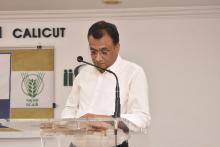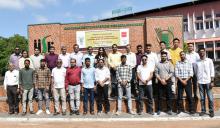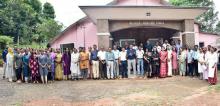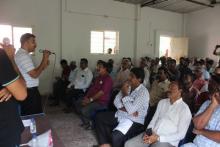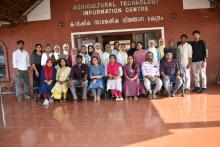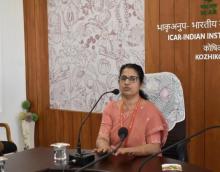TECHNOLOGIES DEVELOPED FOR ADOPTION BY FARMERS
| Name of technology developed | Description | |
| 1 | Zero Energy Chamber | Dimension for a chamber to keep 200 kg of fresh ginger: Double brick structure- outside wall: Length- 180 cm: width- 130;Height- 82 cm Inside wall: Length – 120cm; width- 90 cm; Height- 75 cm Gap between walls – 20 cm During storage the sand can be moistened with water every alternate day which will keep the temperature inside the chamber about 5-7 degree lower than ambient. It can store healthy ginger up to 4-5 months with out damage. |
| 2 | Arecanut + Chaba Intercropping | Java long pepper (piper chaba) is one of the main sources of long pepper. This can be introduced as an intercrop in arecanut plantations. P. Chaba is grown with a spacing of 1.5-2.0 * 1.5 -2.0m. Long pepper is a vine, and therefore, it requires a support to grow. A trial conducted in IISR revealed that around 4000 plants of long pepper could be grown successfuliy in arecanut plantation of one hectare. On an average 135 g dry mature fruit per vine was harvested. At the rate of Rs 60/ kg, produce worth Rs 32,400/- was obtained with minimum effort. |
| 3 | Mechanical Thresher for black pepper | Model: Raspbar-drum type. Speed rpm (m/s) : 450(7.07); capacity : 398 kg/h; Efficiency: Two feeding 98% Breakage : 4.5% Feeding Pattern : Each lot two times. The performances of the thresher was evaluated for the capacity, breakage and threshing efficiency at various speeds of operation. The capacity of the thresher increased from 320 to 400 kg/h as the speed of the drum increased from 300 to 450 rpm. An increase in the speed also increased the efficiency of threshing. The percentage of broken berries was negligible and the threshing efficiency was above 95% at 300 rpm of drum speed. The thresher is operated by a single phase 2 hp motor. The salient features of the thresher are: |
| 4 | Blanching and drying of mace (Myristica fragrans) | Mace, after separation from the kernel was spread in a single layer over the wire-mesh –bottom drying chamber. Hot air drying of mace required 4 h to complete drying. The weight reduction was higher during the initial phases of drying, which then decreased subsequently. The moisture content in unblanched and blanched mace lowered from 1.75 to 0.05 g/g (dm) after 4 h and 3.5 h of drying, respectively.Blanching reduces drying time. After drying,blanched mace acquired a deep red colour and a glossy appearance. Lycopene, the main quality constituent in blanched mace was 22.06% higher as compared to unblanched mace. |
| 5 | Low input nutrient technology for black pepper | For the predominantly small and marginal black pepper growers in Kerala, Application of ½ pop(recommended package of fertilizers) + zinc (6kg/ha as basal) is a risk free rational technology for better returns. However, large and medium farmers with enough resource to spare, application of FYM+ ½ recommended P (25 kg/ha) +Azospirillum (20g vine -1) or FYM + ½ recommended N (70 kg/ha) + Phosphobacteria (20g vine -1) is recommended for better returns. |
| 6 | Integrated nutrient input technology for black pepper |
For higher yield and fertility buildup in black pepper gardens, Coir pith compost can be recommended @ 1.25 t ha-1 integrating with ½ the recommended fertilizer dose and azospirillum sp. @ 20g vine-1 |
| 7 | Drip irrigation schedule for brush pepper | Brush pepper is suited as intercrop in coconut garden. Drip irrigation @ 81/plant/day during October-may is ideal for 5 year old bush pepper for getting maximum incomeand cost benefit ratio worked out for the treatment was2.00 |
| 8 | Granite powder as substitute for sand in rooting media |
Black pepper is commonly propagated through rooting of cuttings using potting mixture consisting of soil, sand and farm yard manure in 2:1:1 proportion. Rate of leaf production (4.6), leaf area (136.8) and biomass (3.9g) of black pepper rooted cuttingswere higher for combination of soil(s), granite powder (G) and farm yard manure(F)SGF 2:1:1 followed by SGF 1:1:1. Production cost of rooted cuttings was less (Rs 3.3/pl) compared to control (3.60). |


